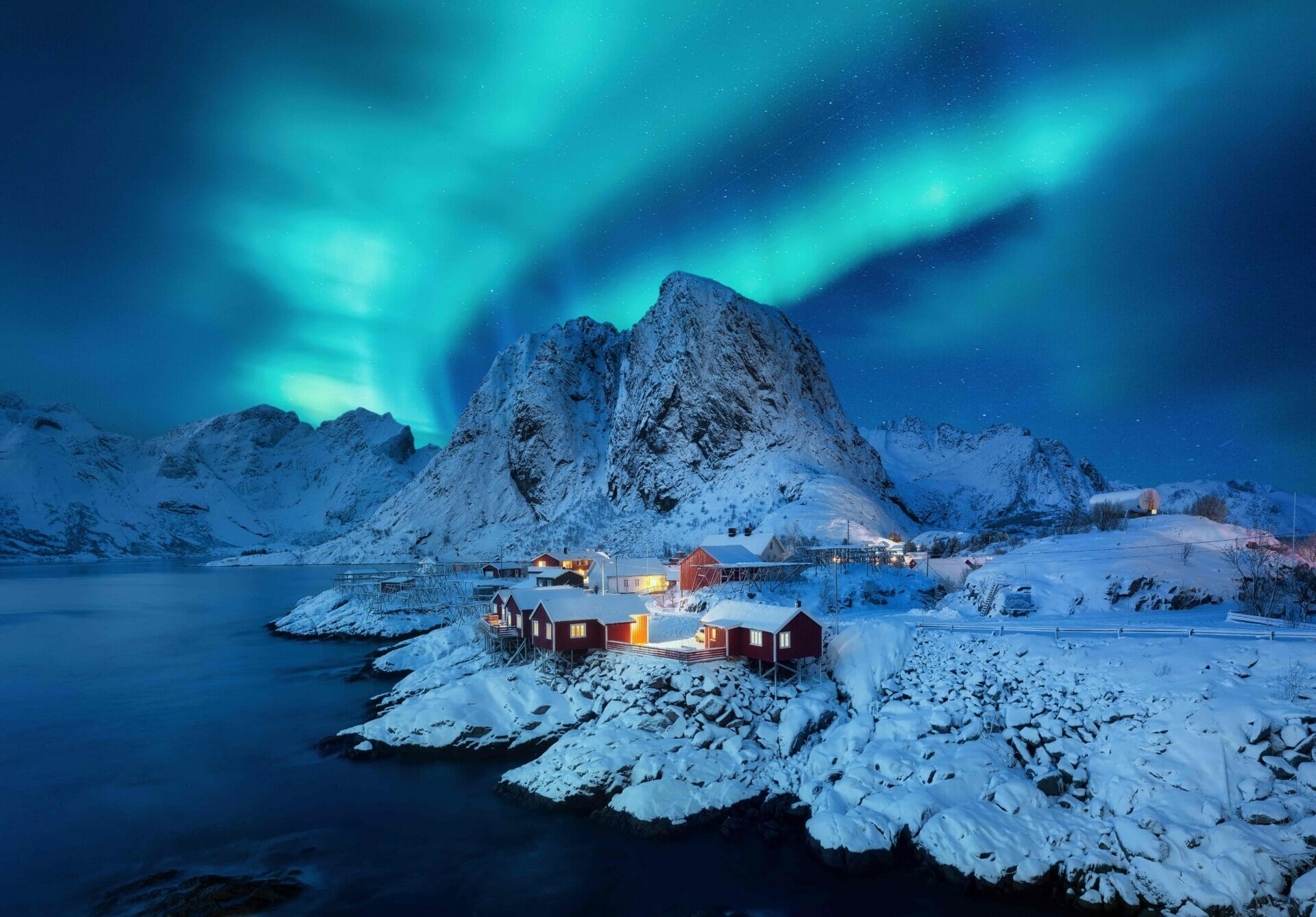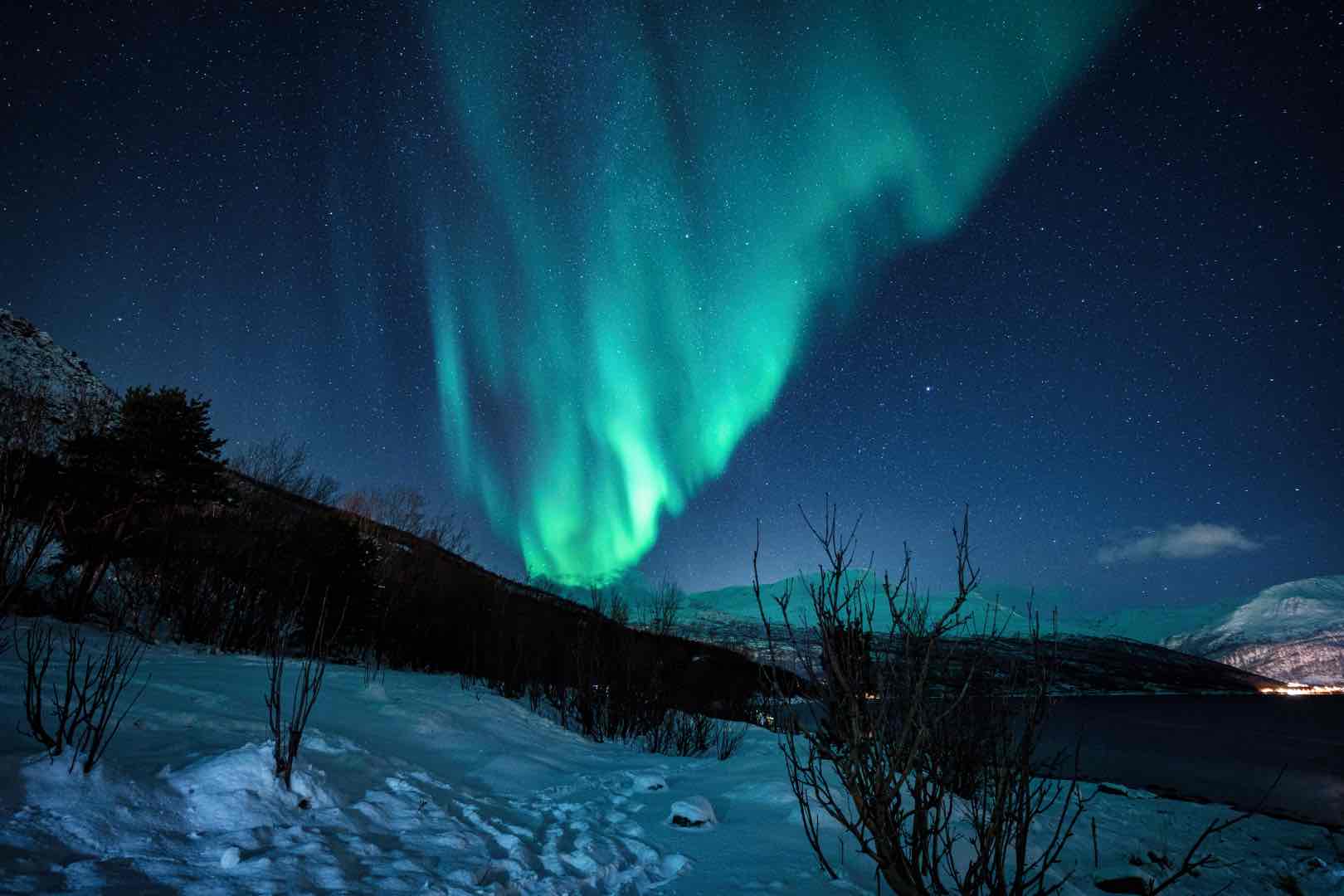Table of Contents
ToggleThe Enchanting Quest for the Northern Lights: Discovering Norway's 5 Best Locations
Introduction
Have you ever dreamed of witnessing the spellbinding dance of the Northern Lights, those ethereal streams of colour that illuminate the polar skies? Norway, with its pristine landscapes and dark, clear nights, offers some of the best vantage points in the world to view this natural marvel. This article delves deep into the heart of this Scandinavian gem, unveiling the 5 Best Locations for Aurora Viewing in Norway. So, bundle up, and let’s embark on this celestial journey to the Arctic Circle!
Be sure to take a look at our other guides to Europe and Norway, such as the Experience Norway’s Majestic Fjords or The top 10 Things to Do in Bergen. Enjoy!

Key Takeaways
Optimal Viewing Locations: The article highlights Tromsø, Kirkenes, the Lofoten Islands, the North Cape (Nordkapp), and Svalbard as the top five destinations in Norway for witnessing the Northern Lights. Each of these locations offers unique scenic backdrops and high probabilities of aurora sightings, enhancing the overall experience.
Best Viewing Season: The ideal time for observing the Northern Lights in Norway is pinpointed between late September and late March. This period is characterised by long, dark nights which are crucial for a vivid display of the aurora.
Cultural and Recreational Activities: Beyond aurora viewing, the article suggests engaging in local cultural and recreational activities. These include experiencing the indigenous Sami culture, indulging in winter sports, whale watching, snowmobile safaris, exploring picturesque towns, and learning about Norway’s Viking history.
Preparation and Planning: Emphasising the importance of proper planning, the article advises visitors to prepare for cold weather and to consider staying for at least a week to increase the chances of witnessing the Northern Lights. It also recommends bringing special gear like warm clothing and cameras with manual settings for aurora photography.
Understanding the Northern Lights: The article educates readers on the scientific phenomenon of the Northern Lights, explaining them as a natural light display caused by the collision of solar particles with the Earth’s magnetic field, resulting in vibrant colours, predominantly green, in the night sky.
Where is the Best Place to See the Northern Lights in Norway?
Tromsø

Tromsø, often referred to as the Gateway to the Arctic, is a premier destination for Northern Lights enthusiasts. Situated well within the Arctic Circle, this vibrant city is right in the middle of the aurora zone, offering a high likelihood of witnessing the aurora borealis. The Northern Lights here often appear as ethereal green curtains, elegantly draping across the star-filled sky. But Tromsø is not just about the lights; it’s a cultural hub with a lively nightlife, historic landmarks, and the well-known Tromsø University Museum, where you can deepen your understanding of the aurora phenomenon.
Recommended tour: Tromso: Northern Lights Chase
Kirkenes

Nestled near the Russian border, Kirkenes is more than just a viewing spot; it’s an intersection of diverse cultures and natural beauty. The town is renowned for its exceptionally clear nights, which make for perfect conditions to view the aurora borealis. The skies here often light up with a spectacular show of vibrant greens and purples, creating a mesmerising display against the serene backdrop of the surrounding wilderness. Visitors can also explore the unique Snow Hotel, engage in king crab fishing, and take part in border-crossing excursions into Russia, adding to the allure of this remote location.
Recommended tour: Snow Hotel Entrance Ticket
The Lofoten Islands

The Lofoten Islands are a wonderland for photographers and nature lovers alike. These islands are characterised by dramatic mountain peaks, sheltered bays, and charming fishing villages, offering a fairy-tale setting for the Northern Lights. The reflections of the auroras on the Atlantic Ocean enhance the experience, creating a surreal and unforgettable spectacle. Besides aurora watching, Lofoten is a haven for activities like fishing, hiking, and exploring traditional Norwegian coastal culture in villages like Reine and Svolvær.
The North Cape (Nordkapp)

The North Cape, or Nordkapp, is Europe’s northernmost point and presents an almost otherworldly landscape for aurora viewing. The area is marked by its dramatic cliff faces and the vast expanse of the Arctic Ocean, serving as a dramatic stage for the Northern Lights. Visitors to Nordkapp can experience the midnight sun in summer, and in winter, the ethereal beauty of the auroras. The North Cape Hall, a visitor centre located on the cliffs, provides exhibitions, a restaurant, and a panoramic view of the surrounding wilderness.
Svalbard

Svalbard, a remote archipelago located halfway between mainland Norway and the North Pole, offers one of the most unique Northern Lights experiences. During the polar night, when the sun doesn’t rise for months, Svalbard enters a period of profound darkness, creating optimal conditions for viewing the auroras. The isolation and minimal light pollution here mean that the Northern Lights appear with an intensity and clarity that’s unmatched. Svalbard is also home to unique wildlife, including polar bears, and offers activities like dog sledding and snowmobiling, making it a truly adventurous destination for aurora hunters.
Recommended tour: Gold Mine Tour
What Other Attractions are There in Tromsø?
Here are a list of other things to do in Tromso:
- Arctic Cathedral: An architectural marvel resembling an iceberg, known for its striking design and beautiful stained glass.
- Polar Museum: Provides a deep dive into the region’s polar expeditions and hunting history, capturing the spirit of Arctic exploration.
- Dog Sledding Adventures: Offers an unforgettable journey through the winter landscape, ideal for adventure enthusiasts.
- Cable Car Ride up Mount Storsteinen: Provides panoramic views of Tromsø and its surroundings, a great way to see the city from above.
- Midnight Sun Experiences in Summer: Offers 24 hours of daylight, perfect for hiking and exploring the nearby fjords.
What is the Best Time to See the Northern Lights in Norway?

To witness the spectacular Northern Lights in Norway, timing is key. The ideal window is from late September to late March when the nights are longest and darkest. This period provides the optimal dark skies needed for the auroras to be visible. The peak hours for aurora sightings are generally between 6 PM and 1 AM. During these months, the solar activity interacting with the Earth’s atmosphere creates the best chance to see the auroral display. It’s important to note that aurora sightings are subject to weather conditions and solar activity, so flexibility in travel plans can be beneficial.
What is the Weather Like in Norway?
Norway’s climate varies significantly from north to south and from coastal to inland areas. In the northern regions, where aurora viewing is prime, winters are typically cold with temperatures often dropping below freezing. Snow and icy conditions are common, creating picturesque winter landscapes but also requiring appropriate clothing and footwear. Summers, especially in the south, are mild and pleasant, perfect for exploring Norway’s natural beauty. Visitors should be prepared for rapidly changing weather conditions and pack accordingly, including warm layers and waterproof clothing.
Related article: Best Time To Visit Norway
Do I Need Special Gear to See the Northern Lights?

To enjoy the Northern Lights comfortably, specific gear is essential. Warm, insulated clothing is crucial to withstand the cold Arctic nights. This includes thermal underwear, a windproof and waterproof jacket, insulated trousers, warm gloves, and a hat. Footwear should be warm and waterproof, ideally with a good grip for icy conditions. For those keen on photographing the aurora, a camera capable of manual settings, including long exposures, is recommended. A tripod is also essential to stabilize the camera during long exposure shots.
How Long Should I Plan a Trip to See the Northern Lights?
For a Northern Lights trip, a minimum stay of one week is advisable. This duration increases the likelihood of witnessing the auroras, considering the unpredictability of weather and solar activity. A longer stay also allows for exploring the diverse attractions Norway offers, ensuring that even if the Northern Lights are elusive, the trip is filled with memorable experiences.
What Other Things Can I Do on a Trip to Norway to See the Northern Lights?
Experience Norway like the Sami people
Immersing in the culture of the indigenous Sami people offers a unique perspective on Norway. Visitors can partake in reindeer sledding, a traditional mode of transportation, and learn about the Sami way of life, including their close connection with nature, traditional clothing, and the famous joik (a form of song).
Indulge in Winter Sports
Norway’s winter landscape is a paradise for snow sports enthusiasts. Activities like skiing, snowboarding, and ice-fishing are popular, with resorts and facilities available for all skill levels.
Go Whale Watching
Norway’s coastal areas, especially in the north, are excellent for whale watching. The waters are home to a variety of whale species, including orcas and humpback whales, offering a chance to witness these majestic creatures in their natural habitat.
Safari on a Snowmobile
A snowmobile safari is an exhilarating way to explore Norway’s winter landscapes. These safaris often venture into remote areas, providing a unique wilderness experience.
Tour the Picturesque Towns
Norway’s towns, such as Bergen and Ålesund, are known for their charming architecture and scenic beauty. These towns offer a glimpse into Norway’s history and culture, with colourful wooden buildings, historic sites, and local museums.
Learn About Norway’s Viking Past
Exploring Norway’s Viking history is a journey into the country’s ancient past. Visiting Viking museums and historical sites, such as the Viking Ship Museum in Oslo, provides insights into the lives, culture, and achievements of the Viking era.
Recommended Tours in Norway
Frequently Asked Questions (FAQs)
While Norway is one of the best locations, the Northern Lights can also be seen in other Arctic regions, including Iceland, Canada, and Alaska.
Aurora forecasts are available but are often subject to short-term changes due to solar activity and weather conditions.
Yes, there are numerous guided tours in Norway that specialize in Northern Lights excursions, offering both expertise and local knowledge.
The chances are quite high, especially in the northern regions, during the peak season. However, sightings can never be guaranteed due to weather and solar activity.
Yes, Norway is well-equipped to handle winter conditions. However, visitors should be prepared for cold weather and shorter daylight hours.
Final Thoughts
Norway’s allure extends far beyond its scenic fjords and Viking lore. It is a land where the night sky comes alive with a cosmic ballet of lights, offering a spectacle that remains etched in memory forever. The 5 Best Locations for Aurora Viewing in Norway are more than just destinations; they are gateways to an otherworldly experience, where the sky whispers ancient tales in hues of green and purple. Whether it’s the urban setting of Tromsø or the remote wilderness of Svalbard, each location presents a unique canvas for the Northern Lights. So pack your bags, and let Norway’s celestial wonders unfold before your eyes.
Add us to your socials!
Thank you for reading!
Related articles: Travel Guides Europe , Best Time To Visit Norway
Recommended websites: Visit Norway

Nick Harvey
Save this post (pin it)
Share this post
More Articles
Note: This post contains affiliate links. When you make a purchase using one of these affiliate links, we get paid a small commission at no extra cost to you.


